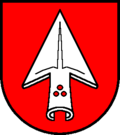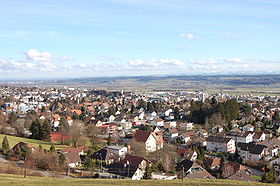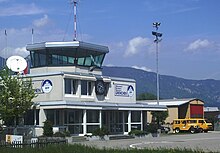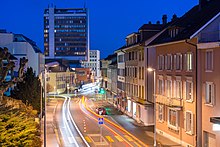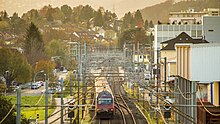Grenchen
| Grenchen | |
|---|---|
| State : |
|
| Canton : |
|
| District : | Livers |
| BFS no. : | 2546 |
| Postal code : | 2540 |
| UN / LOCODE : | CH GRN |
| Coordinates : | 596 758 / 226902 |
| Height : | 451 m above sea level M. |
| Height range : | 422–1403 m above sea level M. |
| Area : | 26.03 km² |
| Residents: | 17,372 (December 31, 2018) |
| Population density : | 673 inhabitants per km² |
| City President : | François Scheidegger ( FDP ) |
| Website: | www.grenchen.ch |
|
View from the north edge of the forest to Grenchen |
|
| Location of the municipality | |
Grenchen (in the local dialect Gränchä ; French Granges ) is a political municipality and capital of the Lebern district in the canton of Solothurn in Switzerland . The village of Staad belongs to Grenchen .
The city lies at the southern foot of the Jura between the cities of Solothurn and Biel / Bienne in Bern . With over 17,800 inhabitants, it is the second largest city in the canton of Solothurn after Olten . The city is known for its watch industry, which has been based for over 150 years.
Neighboring communities are, starting in the north: Bettlach , Selzach , Arch BE , Rüti bei Büren BE , Büren an der Aare BE , Lengnau , Romont and Court .
history
The place is first mentioned in 1131 as Granechun . The name goes back to the Gallo-Roman graneca and means near the grain barns .
The area had been inhabited since ancient times. B. attest to the remains of a Roman manor in Breitholz . A prehistoric cup stone was found nearby . During the excavation work in 1940/1941 a pottery shard and a bronze ring came to light.
The western and eastern municipal boundaries run largely parallel in the Grenchner Witi and in the urban area and are exactly 10'000 Roman feet apart , that is 2.96 km.
Grenchen Castle ("Bettleschloss") dates from the 10th century and is now in the municipality of Bettlach . If it was initially a wooden castle, it was replaced by the barons of Grenchen in the middle of the 12th century with a stone building with a defensive character. The castle burned down around the year 1200, but was restored. In the first half of the 13th century, the Counts of Strassberg , who had their ancestral seat near Büren a. A. had the castle, which from then on was only inhabited by servants. At the beginning of the 14th century the castle was finally given up and left to decay. It appears in the deeds of transfer of ownership until around 1400. At the end of the 16th century, the ruins were used as a quarry for the construction of the prison tower in Grenchen, decided in 1583, and scientifically examined around 1920.
The prison tower in the former castle was demolished in 1806; and its stones were used in building the new Roman Catholic Church. Thus today's St. Eusebius Church consists partly of stones from Grenchen Castle; The grave slabs of the Lords of Grenchen, which were buried in the old church, were also used for the foundation of the new church. However, the tower did not have the current pointed roof, but a helmet roof.
An early painting shows Grenchen as a small village in an open, green landscape. The field name “Kastels” (around 1875 still “Kastelsfeld”) for the north-eastern residential area and the town's schoolhouse may refer to the castle ruins located in the forest slope above (at around 800 m above sea level) or to the Roman villa in Kastels , the remains of which were examined in 2015.
From 1851 industrial watch production began in Grenchen under the pioneers Josef Girard and Urs Schild , which dominates the economic life of the city to this day. In 1857 Grenchen received the first railway connection with the Biel – Solothurn line of the Swiss Central Railway (SCB), which noticeably revived the watch business. The line was electrified in 1927 and expanded to double-track in 1932.
It is also remarkable that in the second half of the 19th century smaller steam-powered ships were allowed to operate on the Aare from time to time.
A hospital fund was founded in 1873 on the initiative of mayor Euseb Vogt . Vogt no longer wanted to see that the growing population of Grenchen - albeit equipped with an improvised emergency station from 1915 - was at a disadvantage compared to that of the Solothurn area. This also violated the legal equality guaranteed in the liberal constitutions of the 19th and 20th centuries . Nevertheless, it was not until 1953 that it was finally possible to finance and build an own hospital. In recent years, however, this has been redimensioned in the wake of efforts to reduce costs; the focus has recently been on internal medicine services . It was closed in 2011.
In 1918, during the nationwide general strike in Grenchen, three young workers were shot dead by Swiss Army troops. During the Second World War, many industrial companies in Grenchen worked for Hitler's Germany, one of them ranked 5th in terms of turnover on a “black list” of the Allies throughout Switzerland.
In the 1970s, the second major watch crisis after the 1930s led to a severe population decline in the city.
politics
Political structure
François Scheidegger ( FDP ) has been city president since September 22, 2013 . Remo Bill ( SP ) has served as Vice-Mayor since May 21, 2017 .
See also: List of Mayors of Grenchen
The executive is made up of the 15-member municipal council, which also includes the mayor and his deputy. The graphic on the right shows the distribution of seats in the municipal council after the election on May 21, 2017.
The legislative branch is the grassroots community assembly that meets at least twice a year.
National elections
In the 2019 Swiss parliamentary elections, the share of the vote in Grenchen was: SVP 29.4%, SP 21.0%, FDP 16.7%, CVP 12.0%, glp 7.7%, Greens 6.7%, BDP 3, 4%, EPP 1.1%, hemp party 1.1%.
coat of arms
The coat of arms shows in the colors red and white an upright ploughshare, seen from above, with three rivet holes. It has existed like this since at least the 17th century.
City partnerships and sponsorships
There are partnerships with the following cities and municipalities:
- Neckarsulm ( Germany ), since 1988
- Sélestat ( France ), since 1988
- Patendorf Unterschächen (Switzerland, Canton Uri ), since 1968
education
The city of Grenchen offers all types of compulsory elementary school , from kindergarten through primary school to upper school. There are also other vocational schools in Grenchen.
Schoolhouses
- Eichholz Schoolhouse
- Kastels schoolhouse
- Schoolhouse Halden
- Schoolhouse II center (built 1883)
- School building III center (built 1912)
- School building IV center
Vocational and adult education centers
- Higher technical school for technology Mittelland
- Commercial-industrial vocational school GiBs
- Institute for Manufacturing Technology
- Commercial vocational school KBS
- VSRT vocational training center
- Adult education center in the Grenchen region
- ZeitZentrum
- Flight school
Library and archive
In Grenchen, the population has access to a city library with a stock of around 44,000 media. The Solothurn Central Library in the region is responsible for a more comprehensive range .
The Grenchen City Archives are located in the listed «School House II» from 1883.
Economy and Infrastructure
Private company
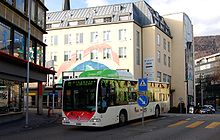
Grenchen has a large and traditional watch industry:
Several other industries have also established themselves in the city.
Town gas was produced in Grenchen for some time . Before the introduction of natural gas, today's municipal works extracted their own gas from coal and wood (coal gasification process).
traffic
The city of Grenchen has an airport on the plain between the settlement and the Aare . Goods can be cleared there ( IATA code ZHI, ICAO code LSZG). It is mainly used by private pilots and parachutists , but also by business aviation , and is one of the most important centers in Switzerland for pilot training. The neighboring GRE radio beacon of an international air route is not connected to the regional airport . The A5 motorway has a connection at Grenchen in the immediate vicinity of the airport.
There are two train stations in Grenchen : Grenchen Nord is on the Jura line from Basel to Biel and Grenchen Süd is on the Jura foot line from Zurich to Geneva.
The Grenchenberg Tunnel , an 8.5 km long railway tunnel, was built between 1911 and 1915. It provides a connection between the Mittelland and Delémont / Basel . The tunnel construction led many guest workers, mainly from Italy , to Grenchen in the construction site village of Tripoli .
Local and regional public transport is operated by the Grenchen and vicinity bus company .
Healthcare
Grenchen has an ambulance service base. Emergency care is taken over by a team from the Grenchen Rescue Service, with two ambulances and an emergency ambulance available. In serious emergencies, helicopter transports are carried out with the Swiss Air Rescue , mostly to Bern's Inselspital .
Grenchen Hospital has been closed since November 2011. Since then, Solothurner Spitäler AG has been running an outpatient health center in these premises. The nearest hospital is in Solothurn.
Culture and sights
Buildings
- The All Saints Chapel stands on a hill northwest of the city. It was built in 1682/1683 and contains rich baroque furnishings.
- In the hamlet of Staad there is a small chapel from the 18th century.
- City Church of St. Eusebius
- In Grenchen, as a city that has only grown decisively since industrialization , there are some valuable buildings from the 19th and 1st half of the 20th century.
In 2008 Grenchen received the Wakker Prize of the Swiss Homeland Security (SHS). The respectful handling of the numerous buildings of the post-war period, the careful further development of the city and the diverse upgrading of public space were recognized. These include the redesign of the market square and the new traffic routing, which relieves the center by means of a meeting zone (see photo above).
Museums
Kunsthaus Grenchen : Since 1984, numerous exhibitions, primarily with graphic art, have been shown in the historic rooms of the "Girardhaus". The modern extension has also been open since 2008.
Since 1999 the former rain school building on the "Absyte" has housed the Grenchen cultural and historical museum . Permanent exhibitions show the history of the city and region of Grenchen, with a focus on the development of the watch industry.
nature
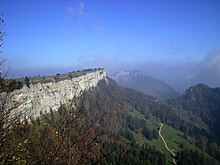
The large nature reserve Grenchner Witi is of national importance. It is home to many rare animal species, primarily bird species (in 1995, for example, around 100 bird species were counted, including the temporarily present migratory birds and the waterfowl on the Aare)
A historical and hydrogeological curiosity is also worth visiting in the «Witi». The Aare, which meandered naturally in earlier times, created the Rütisack in the Grenchner area north of the current course of the river at the height of Rüti near Büren (BE) . This loop of the Aare has dried up at some point and there is only one spot where the backwater can be seen (where an ecologically valuable wetland has arisen). In 1994 the Geobotanical Institute of the University of Bern examined a pollen-analytical test borehole in the Rütisack oxbow lake and found that the beginning of its silting up dates back to the Middle Ages at the earliest . Now it is the case that the bulge of the Rütisack forms exactly the southwest corner of the Bernese-Solothurn border between Lengnau and Grenchen (see the map above). It can be concluded from this that the Rütisack was probably still flowed through at the time the border was drawn between the two federal estates at that time. Lengnau became Bernese in 1388 and Grenchen came to Solothurn in 1393: it is very likely that the Rütisack was still flowed through after 1400, i.e. in the late Middle Ages . For the 17th century, the Geographical Institute of the University of Basel speaks of an advance of the Grindelwald Glacier to its first historical high, over a long 70 years. Because the Aare also carried less water, z. B. here was a possibility of silting up the Rütisack. In any case, a map from 1874 shows that it was already silted up (a building in the middle of the former river bed), the 1st Jura water correction does not seem to have played a role here.
Another noticeable feature of the municipal border in Grenchen is the “hug” of neighbor Bettlach north in the area of the Jurassic ridge, which extends to the next but one municipality territory of Selzach. It is obvious that the Wandfluh rock edge played a role in the elimination of the Obergrenchenberg . The people of Grenchen apparently insisted that this was a natural border for the Bettlacher, while access from the west was relatively unhindered. Remarkably, Rainer W. Walter reports on an episode of bears from Bettlacher Holzhauern around 1750, who apparently felled wood in the Grenchner area above the Wandfluh - probably with Grenchner or the authority's consent and for compensation. Today, in addition to a restaurant, there is also the rotor of a wind power plant on the Obergrenchenberg.
Street names like Vineyard Street , Rebhalde or Traubenweg north of the city suggest that once existed a Grenchner wine. The term Schmelzi-Quartier resp. -strasse is probably due to the fact that there was still a forge and a nail forge there around 1900.
The Grenchen boulder garden in Moosbachtal shows around 60 erratic blocks that were transported into the area by glaciers during the Ice Age.
Events
The International Triennial for Original Prints has been held in Grenchen since 1958 . It is considered to be the world's oldest exhibition for original printmaking and is held every three years by the Grenchen Art Society . A supporting program shows the latest trends in the field of original printmaking. There are also special exhibitions and public campaigns. The MIA (since 2014 GREGA) is a public fair with respective special topics and supporting program, as well as a fairground. It takes place annually.
Grenchen has various theaters. The Parktheater hall serves as a stage for larger performances. There is also the small theater , the Schopfbühne and biennial open - air plays . There is also a comprehensive school for theater (GTG) and a theater studio .
Sports
The most famous football club is FC Grenchen , which plays in the Brühl stadium , which is on the southern outskirts of the city.
In addition to the football club, there is also the SHC Grenchen-Limpachtal, which plays in the highest Swiss street hockey league and won the Swiss Cup on April 28, 2014.
In April 2012 the groundbreaking ceremony took place for the Velodrome Suisse , a multi-purpose hall with a cycling track . The opening took place on June 23, 2013. There Jens Voigt set a new hour record on September 18, 2014 . During the European Championships in 2015, Anastassija Voinova , Russia set a new world record in the 500m time trial in 32 "794 on October 17, 2015. (54.888 km / h)
media
A daily newspaper and a weekly advertisement appear in Grenchen:
- Grenchner Tagblatt
- Grenchen city scoreboard
The city is in the transmission area of several regional radio and television stations:
Personalities
- Franz Joseph Hugi (1791–1855), Roman Catholic priest, geologist and alpine researcher, born in Grenchen
- Giuseppe Mazzini (1805–1872), fighter for Italian independence in the 19th century, found refuge in Grenchen during his persecution from 1835–1836
- Giovanni Domenico Ruffini (1807–1881), English-Italian politician and writer, fled with Mazzini to Grenchen and processed his time in the city in his book A quiet nook in the Jura , published in 1867 (German 1938: From the great time of the Grenchen baths )
- Robert Luterbacher (1846–1912), mayor from 1899 to 1912
- Otto Widmer (1855–1932), founder of the children's home (today: Special Education Center)
- Alfred Kurth (1865–1937), watch manufacturer, governor from 1900 to 1917
- Hermann Obrecht (1882–1940), Federal Councilor from 1935 to 1940
- Adolf Furrer (1897–1978), Mayor from 1933 to 1960 and National Councilor from 1935 to 1963
- Yehudi Menuhin (1916–1999), conductor and violinist, honorary citizen of Grenchen
- René Baumgartner (1930–2018), orthopedist, university professor in Münster
- Ernst Thomke (* 1939), inventor of the Swatch watch
- Boris Banga (* 1949), Mayor from 1991 to 2013, former National Councilor
- Dagobert Cahannes (* 1950), sports reporter and stadium announcer
- Geneviève Lüscher (* 1953), prehistorian, non-fiction author and science journalist, born in Grenchen
- Otto Sallaz , Bücker acrobatic pilot
- Mike Müller (* 1963), actor, born in Grenchen
- Victorine Müller (* 1961), artist (performance, sculpture, video)
- Alex Miescher (* 1968), sports official and former competitive athlete, born in Grenchen
- Sascha Ruefer (* 1972), television presenter
- Silvan Aegerter (* 1980), football player
- Marco Wölfli (* 1982), soccer player
- Vanessa Bürki (* 1986), Swiss Footballer of the Year 2006
See also
literature
- Werner Strub: Heimatbuch Grenchen . Vogt-Schild AG, Solothurn 1949.
- Salome Moser: 100 years of social democratic town councilors in Grenchen: Festschrift for the 100th anniversary . Grenchen 1999.
- Grenchen - your city. Teaching materials 3rd – 4. Class, school administration Grenchen 2010.
documentary
- Karin Berger: The silent majority - Swiss navel show in Grenchen. In: SRF 1 , DOK from April 12, 2018 (51 minutes).
Web links
- Official website of the city of Grenchen
- Urs Zurschmiede: Grenchen. In: Historical Lexicon of Switzerland .
- Urs Zurschmiede: Bachtelen-Bad. In: Historical Lexicon of Switzerland .
- Wiki of the city of Grenchen , a joint project of the Grenchen city archive, the Grenchen cultural-historical museum and the Grenchen Museum Society.
Individual evidence
- ↑ Permanent and non-permanent resident population by year, canton, district, municipality, population type and gender (permanent resident population). In: bfs. admin.ch . Federal Statistical Office (FSO), August 31, 2019, accessed on December 22, 2019 .
- ↑ Solothurn is growing - Grenchen is within reach. Solothurner Zeitung , February 5, 2013, accessed on June 11, 2013 .
- ↑ Walter Drack: The finds of the Roman villa rustica of Grenchen-Breitholz and their dating. In: Jahrbuch für Solothurnische Geschichte 40, 1967, pp. 445–466. - Hermann Hugi: Report on the Roman villa in Grenchen. In: Jahrbuch für Solothurnische Geschichte 15, 1942, pp. 185–188.
- ↑ Werner Meyer: Grenchen Castle. A contribution to scientific castle research . In: Yearbook for Solothurn History . tape 36 , 1963, pp. 142-219 , doi : 10.5169 / seals-324263 .
- ↑ Presentation Burg Grenchen, Alfred Fasnacht's bed lock on the website of the Museum Society Grenchen ( Memento of the original from September 1, 2014 in the Internet Archive ) Info: The archive link was inserted automatically and has not yet been checked. Please check the original and archive link according to the instructions and then remove this notice.
- ↑ Simone Mayer: A Roman water basin in Grenchen. In: Archeology and Monument Preservation in Solothurn, 2016, pp. 61–66.
- ↑ Stefan Frech: Grenchen dependent on the German Reich , section from a special supplement in the Solothurner Zeitung of December 16, 1997. Cf. also the research on this by the Grenchen teacher German Vogt.
- ^ Official publication of the results of the municipal council of the city of Grenchen. City of Grenchen, May 22, 2017, accessed May 25, 2017 .
- ^ Federal Statistical Office : NR - Results parties (municipalities) (INT1). In: Federal Elections 2019 | opendata.swiss. August 8, 2019, accessed August 1, 2020 .
- ↑ Elections and Votes. Retrieved August 5, 2020 .
- ^ Grenchen City Library
- ↑ Business information of the city of Grenchen ( Memento of the original from September 21, 2016 in the Internet Archive ) Info: The archive link was inserted automatically and has not yet been checked. Please check the original and archive link according to the instructions and then remove this notice.
- ↑ Grenchen municipal works
- ^ Grenchen Health Center. Retrieved December 26, 2012 .
- ↑ Stefan Blank: The All Saints Chapel in Grenchen. (Swiss Art Guide, No. 716, Series 72). Ed. Society for Swiss Art History GSK. Bern 2002, ISBN 3-85782-716-5 .
- ^ Grenchen boulder garden , accessed on May 6, 2011.
- ↑ Archive link ( Memento of the original dated February 4, 2012 in the Internet Archive ) Info: The archive link was inserted automatically and has not yet been checked. Please check the original and archive link according to the instructions and then remove this notice. SSHA website
- ^ Website of the Velodrome
